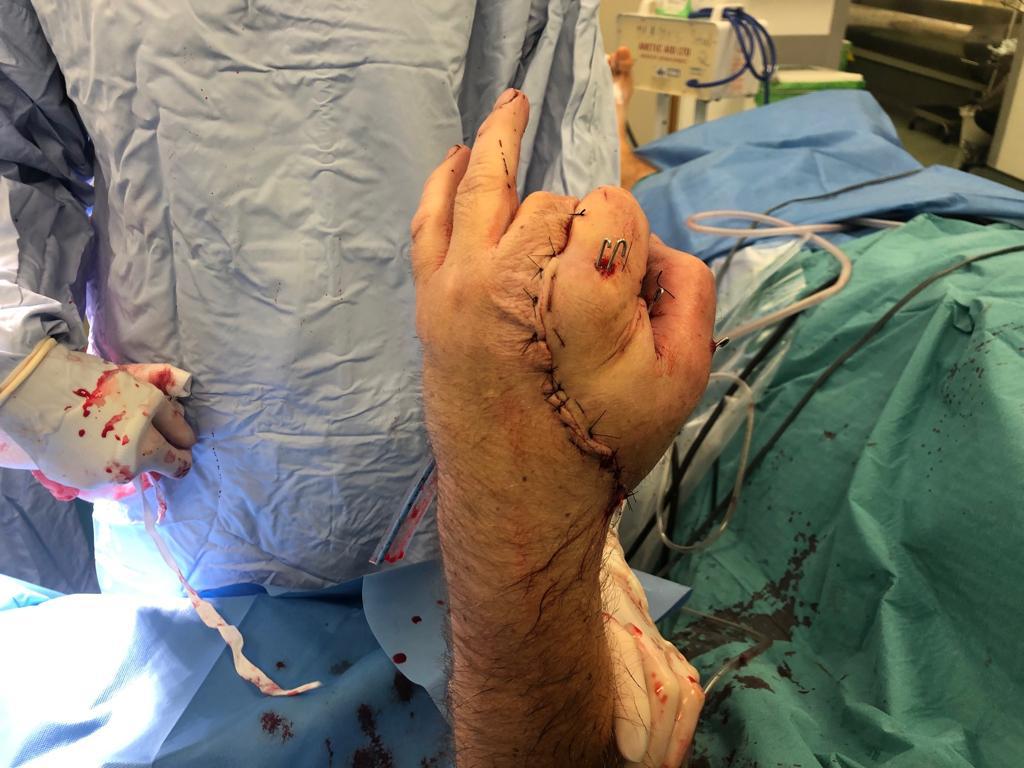A carpenter who severed his hand with an electric saw, leaving it dangling from slivers of skin and bone, had it largely saved after surgeons temporarily reattached it to his groin.
A team of four surgeons at St George’s Hospital in Tooting performed numerous operations, spending around 17 hours in total operating on Anthony Lelliott’s hand in an effort to salvage what they could.
Consultant plastic surgeon Roger Adlard was on call when the 46-year-old arrived at the hospital’s major trauma centre. He said the extent of the damage was worse than he had imagined.
“When we took him to theatre I realised it was much worse than I’d first thought. It had been cut off almost completely in two places – at the base of his palm and again just below the fingers.”
Mr Lelliott, from Walton-on-Thames, remembers little of the accident that saw his hand mangled in a chop saw while cutting up floorboards on May 30.
“I threw myself off the saw. I don’t know whether it was my brain playing tricks on me, but it was like an out of body experience; I could see myself and see what I’d done. There was blood spurting out everywhere.”
He described being rushed into theatre thinking he would wake up without a hand.
Mr Adlard said in cases where amputation was a possibility he did not like to promise his patients anything beyond the fact he would do his best for them.
To ensure the best chance of success the plastic surgeon called on his colleague Farida Ali for the initial operation, and two other specialists Jamil Moledina and Sonja Cerovac for subsequent operations.
“It was going to be a very long operation and if I proceeded on my own then the chance of saving all five fingers was slim.
“Time was also against us; his detached fingers were getting warm and left too long without blood they would rapidly decompose and be impossible to re-attach.”
He said Ms Ali, a microsurgery specialist, was off-duty but agreed to help when she heard of the severity and complexity of Mr Lelliott’s injury.
They worked through the night to save the hand, fixing his broken bones and harvesting nerve and veins from his foot and forearm.
“Farida and I took it in turns, with one of us taking veins from his foot and the other stitching the veins to arteries in his hand using a microscope and a very small needle,” Mr Adlard said.
“We did the same thing for his nerve grafts harvested from his forearm and I repaired any tendons that I could.”
During the surgery they found there was not enough skin to cover his palm and so they called in another specialist colleague, Jamil Moledina, to attach the hand to his groin in an effort to grow more skin.
“Eventually the skin from his groin grew new roots to where it had been transferred to his hand and we were able to cut his hand free,” Mr Adlard said.
After the initial operation the surgeons made the decision to sacrifice Mr Lelliott’s middle finger when they noticed it had little feeling to it.
In a procedure performed by their other colleague, Sonja Cerovac, they effectively filleted the finger to help reconstruct more skin and bone for his palm.
Three months on from the accident, Mr Lelliott has already regained some movement in his hand, with the assistance of the hospital’s hand therapy team.
While things remained a challenge, the carpenter said he was grateful he still had a hand.
“Words can’t describe it because I was expecting to wake up without a hand. It’s just trying to get it to work now. It’s unbelievable really, I’m so grateful.”

